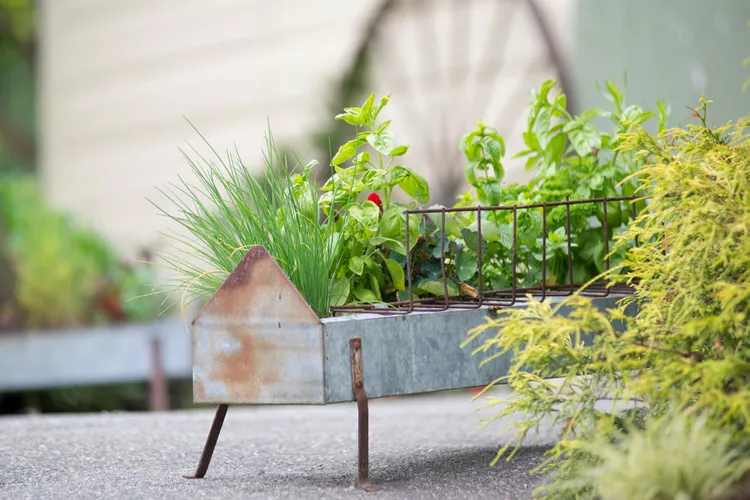Thanks to its strong scent and fast growth rate, basil is often used as a pest-repelling companion plant for vegetables, herbs, and flowers that benefit from extra pest protection. However, the right basil companion plants also improve the health of basil crops by sheltering the tender leaves from hot, bright sun and providing other perks. Here are a few companion plants that benefit from basil’s pest-repelling properties while helping basil grow even better.
Tomatoes
Tomatoes and basil are a match made in heaven and one of the most classic companion planting pairs you can find. Whether you grow plants in containers or garden beds, tall tomatoes can shelter basil leaves from sun damage, and they will return the favor by repelling a variety of tomato pests. What’s more, basil is said to improve the growth and flavor of nearby tomato plants, which is a huge benefit to home gardeners since basil and tomatoes are essential ingredients for making homemade pasta sauce and caprese salad.
Marigolds
Marigolds are famous for their ability to deter pests, but they work even better when they’re interplanted with other pest-repelling herbs, like basil. Some studies have found that thrip populations are reduced by companion planting basil with marigolds. This plant combination is especially beneficial for tomatoes. In addition to adding a cheerful and colorful note to a container or bed, marigolds distract slugs and snails from basil leaves and keep basil plants blemish-free.
Asparagus
With their tall, fern-like fronds, asparagus plants cast shade on lower-growing crops, making them challenging to keep in mixed vegetable beds. However, sun-sensitive basil benefits from the extra shade of asparagus leaves. Interplanting these two companions keeps vegetable beds productive long after the asparagus season ends. Best of all, basil’s strong scent repels asparagus beetles that damage asparagus spears and make the plants less productive.
Peppers
Basil grows well with most nightshade plants, and peppers are no exception. Like tomato plants, peppers and basil have similar growing needs, and basil benefits from the shade that the pepper plants provide. If you allow your basil plants to flower, they will attract pollinators to the pepper crop and boost the pepper harvest yields.
Chamomile
Although chamomile is mainly grown for homemade teas, chamomile’s delicate, daisy-like flowers are surprisingly good at attracting beneficial insects that prey on garden pests. When planted near basil, chamomile flowers entice hoverflies and parasitic wasps to visit and gobble up any basil pests they find. Keep in mind that annual German chamomile, which is grown for tea, is usually better for vegetable gardens and container-growing since it doesn’t need to be overwintered like perennial Roman chamomile, which is primarily used as a groundcover.
Chives
While basil’s aromatic leaves are repellant to many common pests, aphids and Japanese beetles are undeterred by basil’s scent, and they can do a lot of damage to basil. Fortunately, chives repel these pests, protecting tender basil leaves from damage. Chives and basil also have similar growing needs, although chives are typically grown as perennials, and basil seeds need to be planted each spring.
Potatoes
Potatoes are another member of the nightshade family that grows well beside basil plants in roomy containers or vegetable beds. Not only does basil’s short root system not interfere with the growth of potatoes, but its strong aroma repels potato beetles. For the best results, sow basil an appropriate distance away from potato plants so you don’t accidentally disturb the basil roots when harvesting spuds.
Borage
If you’ve never heard of borage, you’re not alone. Borage is an often overlooked companion plant. It boasts edible leaves and flowers that beautify summer salads and drinks and has an impressive ability to repel garden pests such as hornworms. Planting borage and basil near tomatoes enhances the pest-repelling properties of both plant companions. Borage also makes neighboring basil more resistant to pests and disease.
Root Vegetables
Carrots, beets, turnips, radishes, and other root vegetables do most of their growing underground, so they don’t interfere with the growth of taller basil plants. Basil deters carrot flies and other pests that damage root crops and riddle carrots with unsightly holes. Succession sow fast-growing root vegetables throughout the season and use season extension products to shelter frost-sensitive basil plants from early fall frosts to increase harvest yields.
Eggplants
Like basil, eggplants love rich, moist soil and lots of sun, so it’s no surprise that these two plants grow beautifully together in the garden. Basil plants are less likely to develop sunscald when grown beneath taller eggplants, and eggplants gain some pest protection from the strong scent of basil leaves. Remember that eggplants and other nightshades are heavy feeders, and they should be fertilized regularly throughout the season to ensure they don’t draw nutrients away from basil and other neighboring plants.




















